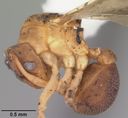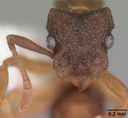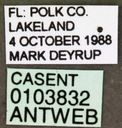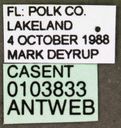Cyphomyrmex minutus
Classification
- Phylum: Arthropoda
- Subphylum: Hexapoda
- Class: Insecta
- Order: Hymenoptera
- Superfamily: Formicoidea
- Family: Formicidae
- Subfamily: Myrmicinae
- Tribe: Attini
- Subtribe: Attina
- Genus: Cyphomyrmex
- Species: minutus
Pronunciation
How to pronounce Cyphomyrmex minutus: /ˌsɪfoʊˈmɜrmɛks mɪˈnjuːtəs/
These audio files are automatically generated. While they are not always 100% accurate, they are a good starting point.
Images






Summary
Cyphomyrmex minutus is a species of fungus-growing ants that exhibits unique nesting behaviors and a dependence on its cultivated fungi for survival. It is part of a rich ecological network, contributing to the cultivation and management of fungal gardens, facilitating interactions between various organisms.
Physical Characteristics
Part of the Cyphomyrmex rimosus group but smaller than Cyphomyrmex rimosus, without a deep hairless furrow on the dorsum of the postpetiole or only a faint short furrow. The frontal carinae on the head form a shield, and the mesosoma has a series of blunt tubercles.
Identification Tips
Species in the rimosus group can be noted by their anteriorly open antennal scrobe and the five teeth on their mandibles; the strigatus complex has a closed anterior antennal scrobe with six or more teeth on the mandibles.
Habitat
Common nest sites include soil, under rotting logs, within hollow and dead twigs. Some species create swallow nest-like structures made of soil or clay, typically in moist environments.
Distribution
Central South America, reaching Argentina, stretching into North America from Texas to California and east to Florida.
Diet
Primarily mycophagous; the larvae are groomed by workers to promote fungal growth on their integument, while workers also consume sugary substances derived from plants.
Life Cycle
Undergo complete metamorphosis with distinct stages from larvae to adults, with workers progressively moving out of the colony as they age.
Reproduction
Typically monogynous colonies with queens relying on fungal gardens for nourishment for the first generation of workers.
Predators
Specialized wasps in the family Diapriidae can parasitize larvae, which can lead to significant mortality rates.
Ecosystem Role
Fungus cultivators playing a significant role in their ecosystems by managing fungal growth and contributing to nutrient cycling.
Evolution
Part of a more basal phylogenetic relationship within the tribe Attini; their chemical profiles are thought to be a base for the more complex mixtures found in higher genera.
Similar Taxa
- Myrmecophilous fungi
- Myrmecophytes
- Attine ants
- Trachymyrmex
Misconceptions
They are sometimes confused with other ant species due to similarities in size and nesting habits.
Tags
- ant
- fungus-growing ant
- Cyphomyrmex
- ecology
- neotropics